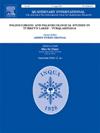Wood use and forest resource management at Pompeii. Anthracological analyses in the area of Regio VII, Insula 14
IF 1.8
3区 地球科学
Q3 GEOGRAPHY, PHYSICAL
引用次数: 0
Abstract
During the archaeological excavations of civici 1 to 4 of the Regio VII, Insula 14 of Pompeii, an extensive anthracological sampling, which involves different domestic spaces and structures, was carried out. This paper brings new elements to the knowledge of the past landscape and vegetation cover in the area and allows to reconstruct wood use strategies, for firewood and timber, in the not well-known context of past domestic daily life and shops productive activities. Overall, 2038 charcoal fragments were analysed, covering a broad chronology from the late 3rd century BC to 79 AD. Among them 24 plant taxa were identified, relating to both deciduous and evergreen trees. Our results partially confirm previous data about Pre-Roman and Roman Vesuvian landscape, but also present remarkable peculiarities, like the absence of remains of species such as cypress, cedar, or chestnut, which were broadly used in valuable carpentry. The existence of a high degree of selectivity, as regards both timber for building, furniture, artifacts making, and firewood was detected. The most used wood trees were Fagus (beech) and Abies (fir), followed by various meso-thermophilous broadleaved trees, a few Mediterranean evergreen species and some cultivated fruit plants (Olea, Juglans, and Vitis). Local inhabitants may have preferred these species as a consequence of various factors, including technical features, good availability and socio-cultural drivers.
庞贝城木材利用与森林资源管理。14岛第七区地区的人类学分析
在对庞贝城第七区,14岛的1至4号区进行考古发掘时,进行了广泛的人类学采样,其中涉及不同的家庭空间和结构。本文为该地区过去的景观和植被覆盖知识带来了新的元素,并允许在过去不为人所知的家庭日常生活和商店生产活动背景下重建木材使用策略,用于木柴和木材。总的来说,分析了2038块木炭碎片,涵盖了从公元前3世纪晚期到公元79年的广泛年代。其中鉴定出落叶乔木和常绿乔木共24个植物类群。我们的研究结果在一定程度上证实了之前关于罗马前和罗马维苏威地貌的数据,但也呈现出了显著的特点,比如没有柏树、雪松或栗子等物种的遗迹,这些物种被广泛用于有价值的木工。在建筑木材、家具、手工制品和柴火方面,存在着高度的选择性。最常用的木材树种是Fagus(山毛榉)和Abies(冷杉),其次是各种中温阔叶树,一些地中海常绿树种和一些栽培果树(Olea, Juglans和Vitis)。当地居民可能由于各种因素而偏爱这些物种,包括技术特点、良好的可用性和社会文化驱动因素。
本文章由计算机程序翻译,如有差异,请以英文原文为准。
求助全文
约1分钟内获得全文
求助全文
来源期刊

Quaternary International
地学-地球科学综合
CiteScore
5.60
自引率
4.50%
发文量
336
审稿时长
3 months
期刊介绍:
Quaternary International is the official journal of the International Union for Quaternary Research. The objectives are to publish a high quality scientific journal under the auspices of the premier Quaternary association that reflects the interdisciplinary nature of INQUA and records recent advances in Quaternary science that appeal to a wide audience.
This series will encompass all the full spectrum of the physical and natural sciences that are commonly employed in solving Quaternary problems. The policy is to publish peer refereed collected research papers from symposia, workshops and meetings sponsored by INQUA. In addition, other organizations may request publication of their collected works pertaining to the Quaternary.
 求助内容:
求助内容: 应助结果提醒方式:
应助结果提醒方式:


